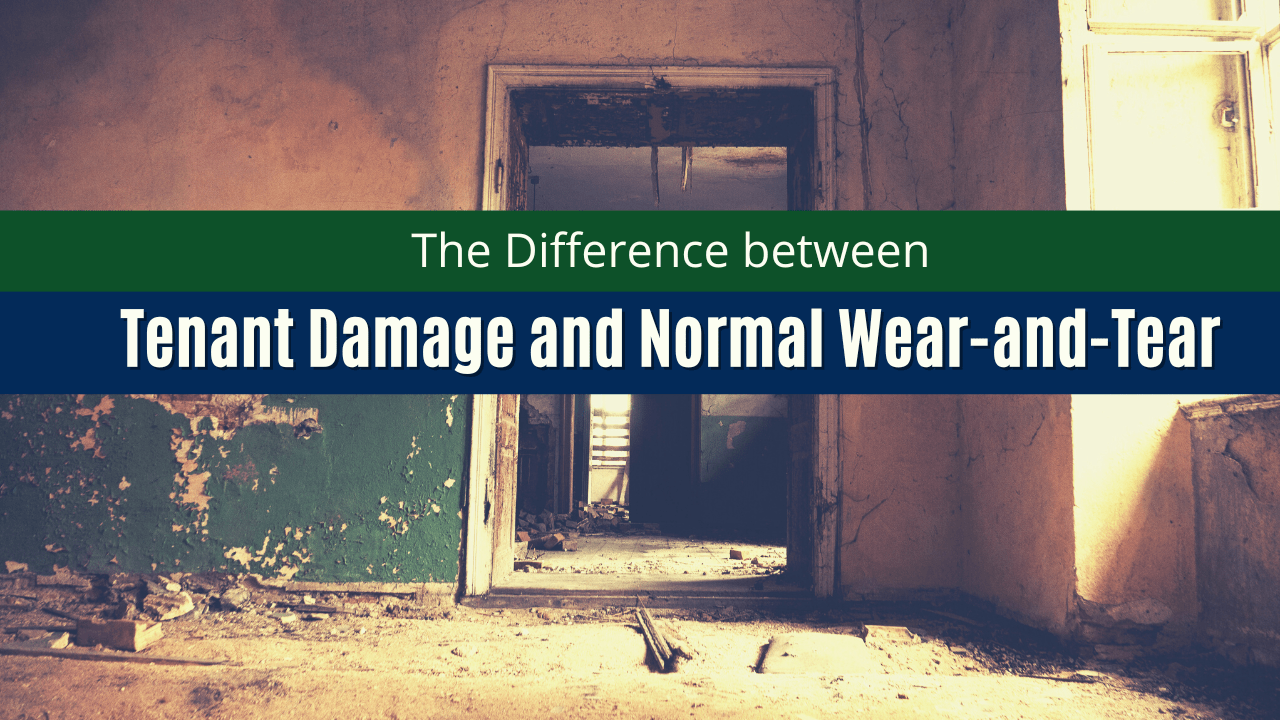If you are planning to rent out a home in Golden, Colorado, you’ll need to understand the difference between normal wear and tear in a rental property and tenant damage. This isn’t as easy as it may seem. In our experience, most owners and landlords will believe that almost everything is an indication of tenant damage. And, tenants will almost always insist that “it was like that when I moved in.”
This can be difficult to navigate when you’re not prepared.
The distinction between wear and tear and tenant damage isn’t simply a matter of opinion. It also impacts the security deposit and how it’s returned to your tenants. In Colorado, landlords have security deposit laws that must be followed when they’re renting out a property. For example, you cannot collect a deposit that is non-refundable. You also cannot charge wear and tear issues to the departing tenant’s deposit.
At the end of the lease term, you have a specific amount of time in which to return the deposit to your tenant. Before that time period expires, you’ll need to know what qualifies as damage and you’ll need to know what it will cost to repair it. The move-out process needs to be efficient and informed.
How do you know when you’re looking at general deterioration and when is it considered damage? We’re going to talk about some ways to avoid making any potential mistakes. Those mistakes could result in tenant disputes, court appearances, and expensive penalties (up to three times the amount withheld).
Let’s Define Normal Wear and Tear in a Golden Rental Property
Wear and tear is the general deterioration that happens to a property regardless of who is living there. The scuff marks on the wall where furniture was resting and the worn carpet in high traffic areas are going to happen. They’re expected.
Some of these things you’ll likely notice at your own home as well. Everyone experiences this type of wear, and that’s why tenants cannot be held accountable for the results of it. There’s often little that can be done to prevent it.
Additional examples of normal wear and tear might include:
- Small nail holes in the walls from where pictures were hung.
- Loose grout between tiles, especially in the bathrooms.
- Doors or cupboards that have warped over time.
- Faded paint.
- Door frames or window frames that may have warping.
- Blinds that may have faded from sunlight.
- Scuffs or dents in walls behind doors (from door handles).
- Minor carpet staining or discoloration.
- Slight scrapes or marks on a hard floor.
- Finishes wearing away, staining, or rusting.
These are not things you would normally charge for when a tenant moves out and you’re preparing the property for a new resident. This inevitable physical decline occurs during the course of a tenant’s occupancy.
The longer a tenant occupies your property, the more wear and tear can be expected. If a tenant has been in place for 10 years and the walls have not been painted in that entire decade, you’re going to expect that you’ll have to repaint before a new tenant moves in. You’ll likely need to install new carpet or flooring and update your appliances and fixtures. These are not your tenant’s responsibility.
Defining Property Damage in a Rental Home
Unexpected property damage, on the other hand, is something that harms the value, usefulness, or normal functioning of your rental property and its systems. Generally, it’s unintentional. Damage is the tenant’s responsibility, but the tenant likely did not set out to damage your home. It’s the result of abuse and neglect, not ordinary use.
You wouldn’t expect cracked windows or missing floor tiles from normal, everyday use. This type of damage doesn’t occur naturally because a person is living in the home. It instead may have happened on purpose, by accident, or due to neglect.
Property damage can be done intentionally by your tenant, but most often it’s accidental. It clearly goes beyond wear and tear, and in order to use your security deposit funds to pay for it, you must be able to document that the property didn’t look like that when the tenant moved in. That’s why move-in inspection reports are so critical.
Examples of property damage may include:
- Large holes in the walls or floors.
- Changes to the property, such as different paint colors that were not pre-approved.
- Tears, stains, or holes in carpet.
- Water stains on wood floors.
- Broken appliances, doors, or windows due to abuse.
- Missing or cracked bathroom tiles and mirrors.
- Writing on walls, floors, and surfaces.
- Yards or gardens that have been destroyed due to animals, cars parked on them, or excessive trash.
When you’re withholding money from the security deposit to pay for these things, document the amount you’re spending and why. You’ll need to provide an itemized list to your tenant that explains why they aren’t getting the full deposit back – or any deposit at all.
Colorado Security Deposit Laws and Tenant Damage
Before you decide what you can and cannot deduct from your tenant’s security deposit based on your decisions about what qualifies as damage and what is simply wear and tear, you need to understand some important legal timelines.
Under Colorado law, you are required to return the tenant’s security deposit within one month of the tenant moving out. This is unless your lease agreement specifies a longer period of time. The absolute limit is 60 days. If you think you’ll need more than a standard month to determine how much you’ll have to pay to restore any damage at your rental property, make sure your lease reflects that you’ll be sending back the deposit in 45 days or up to 60 days. Otherwise, you’re tied to the 30-day turnaround.
There are specific reasons for which you can withhold all or some of that security deposit. These are:
- Unpaid Rent
- Damage in Excess of Normal Wear and Tear
- Abandonment of the Premises
- Tenant’s Unpaid Utility Bills
- Tenant’s Unpaid Repair Bills
- Tenant’s Unpaid Cleaning Bills
The second bullet point is clearly the most relevant for our discussion in today’s blog. You are legally entitled to keep money from the deposit to cover damage.
But, you have to be sure it’s damaged.
If you have withheld any portion of your tenant’s security deposit, you’re going to provide a written itemized statement along with the portion of the security deposit that the tenant is getting back. This statement must specifically list each reason for deduction along with the amount deducted. If you’re deducting for damage, we recommend you include invoices that will reflect detailed and accurate costs. If you haven’t been able to get the work done yet, include a written quote or estimate.
When you don’t provide this written statement, you’re giving your tenants a good reason to dispute the security deposit charges. This could result in losing the money you kept. A court could order it returned to the tenants. This is how important that itemized statement is.
Send the security deposit and/or the itemized written list to the tenant’s last known address. Part of your move-out process should be collecting the forwarding address.
Avoiding Disputes over Damage and Deposits
 Typically, most conflicts between landlords and tenants involve the security deposit. Tenants always expect to get their full deposit back, and they get upset if you keep any money to pay for damage to the property. This illustrates the need for good documentation.
Typically, most conflicts between landlords and tenants involve the security deposit. Tenants always expect to get their full deposit back, and they get upset if you keep any money to pay for damage to the property. This illustrates the need for good documentation.
You can avoid tenant disputes by taking exhaustive photos of the property before they move in. You’ll want to account for every wall, floor, ceiling, and surface. It’s hard to argue with photos. Make sure your inspection report is thorough, signed by the tenants, and filed away for the end of the lease term. At Laurel Property Services, Inc. we have the tenants do an electronic walkthrough, which requires photos of previous damages.
Conduct a similar inspection after your tenants move out. This is where you’ll document the damage. Take exhaustive pictures. Make detailed notes. There should be no doubt that the damage is real and caused by your tenants. It’s the only way to avoid a legal battle or a dispute with your tenants.
If you fail to follow the security deposit laws in the state of Colorado, the tenant could be awarded up to three times the amount wrongfully withheld, plus reasonable attorney’s fees and court costs. That’s going to add up to a very expensive mistake. When a tenant comes to you with questions, explain in detail why you made the deductions you made. Think about the strength of your case and whether you want to risk a court date.
If the tenant has the intention of filing a legal suit against you, they are required to notify you at least seven days before they do. Use those days to return any amount that may have been wrongfully or unintentionally withheld. It will save you from having to go to court.
No one likes to argue with tenants about wear and tear and damage. If you’d like some help ensuring you are correct about identifying wear and tear versus tenant damage, please contact us at Laurel Property Services, Inc. In addition to providing property management in Golden, we also serve Wheatridge, Morrison, Lakewood, Arvada, and Genesee, CO.



